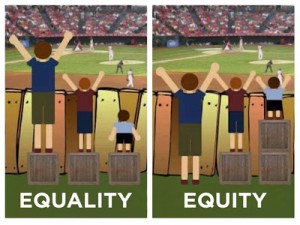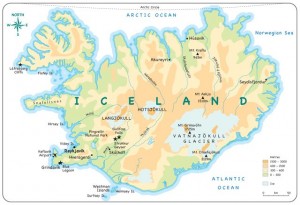In my first article, I introduced the Global Gender Gap. The Global Gender Gap is meant to represent how balanced a society is. Based on how it measured a variety of variables, I concluded that it measure Women’s Status in a society. It was quick to ignore any advancement women had and any instances of men being dominated by women.
So I decided to take a more honest look at the stats from this study to determine how Egalitarian each country truly is. Now, how they measured each variable is suspect. However, I want to use their numbers to show that they derived at the wrong conclusions.
The main problem they have, if you read my last article, is that they measured how women compare to men. That was their main focus. In instances where women outdid men, they treated as the same as women being equal to men. This was divided up amongst workforce, education, health, and politics. Unfortunately, to provide simple numbers to these doesn’t properly represent the complexity of each issue. In this article, I will go over each of these sections to determine how I used this research to derive at my conclusions.
We’ll start with overall methodology. As mentioned (over and over), this compared women to men. I changed this, by taking the Absolute Value of Men and Women. I subtract one from the other. Since it is an absolute value, it measures the distance of the number, and always returns a positive value.
For example: ([] represent Absolute Value)
[50 – 35] = 15
[35 – 50] = 15
In this example, we see that the distance between the two values equals 15. It doesn’t matter if women were on top or men were. All that matters is the difference between the two, and this new number is not gendered. Another way to look at Absolute Value is how far from 0 it is. Even if we return with a -15 in the second example, it is still 15 numbers from zero.

I call this new number, the Egalitarian Differential. This technique measures how close a country is to being Egalitarian in any field, based on the principals of equality. Now we know that in a true Egalitarian society, equality cannot truly exist, instead there would be a measure of equity. However, this original test attempted to prove equality, so I am showing how wrong they were at which countries were more, or less, equal to each other.

Workforce
The key thing in the Workforce that helped some countries and hurt many others was the Wage Gap. In the US, it was stated that the average salary between men and women were the same, yet the Wage Gap was .66, or that women made 66% of what men do. Makes no sense. So I based the ‘Wage Gap’ based on the Income for men and women.
However, there’s a slight problem with that. Take Sweden and Rwanda. Taking the difference between the genders, Sweden has a $2,000 difference. The men and women of Rwanda, on average, doesn’t make $2,000 a year. The difference between them is $300. So then, is it fair that the difference for Rwanda is smaller than Sweden? In light of this, while measuring the difference in average salary, I set the wage gap to be based on $60,000, and how each country compared to that based on the difference between the men and women’s salary in each country. What this does is set every country to the same standard to be equally compared to and the differences in their average salary is properly reflected in their wage gap.
Education
There were no major changes to this, except how I measured the final result using Egalitarian Differential.
Health
Since birthrate is not a true measure of how Egalitarian a society is, I took out the variable. Instead, Health only measures the average age of death between men and women.
Politics
In many countries on this list, leaders are elected. Not all, but many. Due to this, I took out this stat, because politicians are often elected for their position, and not what’s between their legs. People in these countries are able to vote for who they want. There are countries however where the people don’t decide who their leaders are. However, if I exclude it for some, I must do it for all of them.
Results
With the changes above, I did a spreadsheet using the stats of the studies, using the Egalitarian Difference, on the top 25 countries. This was the results:
- Switzerland
- US
- Germany
- Australia
- Sweden
- Rwanda
- Ireland
- Moldova
- Norway
- France
- Denmark
- Finland
- Belgium
- Ecuador
- Netherlands
- Canada
- Philippines
- Latvia
- Slovenia
- Nicaragua
- Iceland
- United Kingdom
- Bulgaria
- New Zealand
- South Africa
Based on the statistics from this report, Switzerland is the most Egalitarian Society. In second is the United States and a close third is Germany.
Don’t worry if your country appears low on this list. You have to remember that the initial study was biased to tell a Narrative. I tried my best to take out as much bias as I could, but in the end, I’m still using their stats.
All I really did was modify the wage gap based on salary, took out birth rate and politics, and changed how the variables were measured. In this, Iceland went from being the top country to being in the bottom five of my list.
ABOUT ICELAND

What do we know about Iceland? Well, it is a country of 40,000 square miles (103,000 km²) with over 300,000 people. It became a Republic in 1944. In 1983, it was the first country to have a woman led political party. They were able to get 15% of the parliament position filled by women. The group merged with another political party in 1999, but 2009, Iceland has about 33% women in government positions.
In 2007, it was ranked 1st Place for the strongest economic growth, but in 2011 dropped to 14th place as a result of the economic crisis. It is also considered one of the lowest income inequality countries in the world. In 2010, it became the first country in the world to legalize same-sex marriages, as their laws are gender neutral. It is said that Egalitarianism is highly valued amongst the people.
As Iceland went from the top to do the bottom, Switzerland went from the middle of the list of the top 25, to the top. So what do we know about Switzerland?
ABOUT SWITZERLAND

Switzerland is over 15,000 square miles (40,000 km) with over 8 million people. It was established as the Swiss Confederation 1 August 1291. It has had a long history of neutrality in wars, and has not had a war since 1815. Though it didn’t join the United Nations until 2002. It is also the birthplace of the Red Cross.
Switzerland has the highest nominal wealth per citizen, and the second highest life expectancy rate. Zurich and Geneva have been ranked as two of the highest qualities of life. It makes use of something called Direct Democracy, established in 1848. It allows the citizens to introduce bills and to vote for laws to be passed. Like Iceland, it has a very low unemployment rate.
Switzerland is multi-ethnic, sharing much of its diversity with race, nationality, and religion with the countries surrounding Switzerland. While it was late in giving women the right to vote (1971), in 2003, Zurich elected more women to the government than they did men. Women do serve an active role in government.
It’s easy for us to throw hate at Switzerland for what it seems to be a lack of gender equality, you have to remember that Switzerland citizen generally decide laws in the country, and elect who they want to represent them. While they dropped the ball on giving women the right to vote, women are able to vote now and people have more power to make changes in Switzerland than anywhere else in the world.
Looking at these two countries, it appears that the measure of politics in their respective countries set them apart. However, taking that out and measuring actual egalitarianism, Iceland, that is supposed to be all about Egalitarianism, did so poorly. Now either the hype about Iceland is false, or this study did a poor job in representing Iceland.
The reasons that Germany and Switzerland did so well was in Education. Both the US and Iceland have more female representation in higher education than Germany and Switzerland who are fairly balanced.
However, the US in its workforce had the lowest score. Despite what feminists might say about the work force, according to this study, it is the highest. The US had a score of 35, followed by Australia at 43 and Norway at 45. Iceland does come in 5th at 60. The rest of the top 20 countries fall within 60 – 90.
Now I did calculated with the weights, and the list remained relatively the same. I won’t include that here, as I don’t agree with how the values were weighted, nor do I have the expertise (or even the salary) to properly calculate how those are weighted. I may also be biased as well. So I will not show you that information, and just work off of the scores I obtained of the Egalitarian Differential.
What does this ultimately mean? We know that Feminists will use faulty testing methodology to maintain their threat narrative. What started me on this journey is wondering how Iceland was the most Gender Balanced society. It would appear it is not the most Egailitarian, rather it is the most Female Dominated society (or close to it).
Equality is not females controlling males, yet many Feminists are pushing for that. These same people respond to criticism of feminist politics by telling their critics to look up the dictionary definition of Feminism, then citing oppression and sexism if you disagree with them.
Whether you choose to agree with my math, or not; you can definitely see that this testing had female only in mind, especially listing this as a Female-to-Male Ratio.
To test how accurate my findings were, I took 3 countries from the bottom of the list. The results:
Original
Iran: 0.581
Pakistan: 0.552
Yemen: 0.515
Mine
Iran: 253
Pakistan: 316
Yemen: 339
The overall score for the U.S. is 75 points away from being a perfect Egalitarian society, Yemen is 350% further away than the US. In this instance, it would appear that my results and the Feminists results agree that Yemen is the worst country with our separate methodology.
This study attempted to ascertain how balanced a society was based on gender. It collected stats from a variety of sources and then interpreted those results. It was dishonest in that interpretation, putting more weight on variables that had less value in a society so it could undervalue anything they saw as accomplishments by women. This was not only destructive for men; it was also destructive for women. There are some big issues out there than many organizations are fighting for and to be undermined by a survey such as this is insulting to everyone.
For a society to be truly egalitarian, is that all genders and races must be given equal representation within a society and have the full potential to be who they want to be within the confines of the rules set by society. Said rules must allow for equity, rather than a perverted sense of equality.
Whether or not my results represent the truth about which countries are the most Egalitarian, we can agree that how the information was presented by Feminists was wrong. Placing more focus on Elementary Education, more focus on voter-required elections, and on the rate of birth of women in society, rather than focus on health issues, on the work force, and on College Education. More than that, this study measured only the inequality women face, verses the one that both men and women face, and undervaluing women accomplishments to paint a narrative.
In the end, I move that a better study be conducted, and the truth of this study be exposed for the fraud it represents.
- The Worst Crime - December 3, 2016
- Feminists Inject Shame Into Male Contraception - November 2, 2016
- Is there Racism While Driving? - September 22, 2016